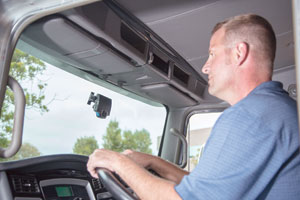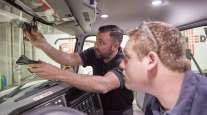Managing Editor, Features and Multimedia
Trucking Firms Gain Liability Protection Through Use of Video Onboard Cameras (includes video)

A growing number of fleets are installing onboard video cameras in their trucks to monitor driver behavior and improve safety, but another key benefit — liability protection — also is playing a central role in the proliferation of that technology.
In a crash, cameras can capture footage of what happened during an incident, potentially preventing a costly judgment or settlement in cases where the truck driver was not to blame.
“In this day and age, you’d be crazy to operate a heavy-duty vehicle without one of these,” said Dan Volpe Jr., chief operating officer at Volpe Express Inc. “When there’s a claim made against us and it’s in that video, it can really back us up.”
The Phoenixville, Pennsylvania-based carrier deployed in-cab cameras from SmartDrive Systems across its fleet of 150 trucks in 2013, in large part to protect itself from litigation in an accident.
In the two years since then, Volpe probably has saved between $500,000 and $750,000 in liability costs from video that captured events and exonerated the fleet and its drivers, company executives estimated.
The most prominent video-safety systems on the market today typically incorporate both a forward-facing camera that records the road ahead and a reverse camera that faces the driver. When triggered by an event such as a collision, a hard-braking incident, speeding or a lane departure warning, these systems transmit video clips showing what happened immediately before and after an incident so fleets know what actually happened on the road.
J&R Schugel Trucking Inc., a refrigerated and dry van truckload carrier based in New Ulm, Minnesota, rolled out the DriveCam system from Lytx Inc. across its fleet of 600 tractors in July 2014.
Since then, the fleet has encountered three to five incidents where having the video recordings may have prevented the company from facing multimillion-dollar settlements or court cases, said Clay Merches, vice president of safety and human resources.
“Plaintiff’s attorneys sit out there and look through every accident report and police report and try to chase settlement dollars,” he said. “Now we have some defense for that, and that’s where the big dollars come back into play.”
Sister companies Truline Corp. and Estenson Logistics also deployed the DriveCam system across their combined fleet of 1,200 trucks at the beginning of the year.
Paul Truman, president of the two carriers, said liability protection has been one of the key benefits of the technology.
He cited one case where a passing motorist reported that one of the company’s trucks dropped cargo on the roadway, causing another car to swerve into a ditch to avoid it. Two people were ejected from the car.
Onboard video, however, showed that the initial report was inaccurate and that there was no cargo loss at all; the car simply sped past the truck, lost control and went into the ditch, Truman said.
He also recalled an accident where a pickup truck veered into the side of a company truck. When the highway patrol officer arrived, the driver of the pickup accused the truck driver of changing lanes into him, but the truck driver refuted that claim and had the video to prove it.
“We need to have some way to protect ourselves and some way to protect our drivers, and this is a good way to do it,” Truman said.
In other cases, however, the video can contradict a driver’s story or show that the truck driver was at fault in an accident. But that information is also valuable, he said.
“That helps us to identify more quickly when we are at fault so we can take care of that and move on, not drag it out,” he said.
Estenson, based in Mesa, Arizona, is a dedicated carrier that operates a fleet of 1,000 trucks, mostly day cabs, while Las Vegas-based Truline is a truckload carrier with a majority of its 200 trucks being sleeper units.
Rob Bartels, senior vice president of trucking and transportation at Lytx, said video can serve as “the ultimate truth teller.”
“You don’t have to rely on unreliable witnesses or police reports, which can be notoriously wrong or misguided,” he said. “Every carrier wants that protection.”
Telematics provider PeopleNet, which is planning to enter the video-based safety market with a product of its own later this year, has made liability protection the first priority for its new system. And that is by far the biggest return on investment fleets can reap from video, said Mike Nalepka, the company’s general manager of video intelligence.
“As we go down the road, a typical trucking company is going to have a very difficult time surviving in the litigation climate that we’re in without having the protection of video,” he said.
Nalepka said the majority of crashes that involve a Class 8 vehicle are not the truck driver’s fault, but he said that litigation attorneys nonetheless have placed a bull’s-eye on trucking companies, which many times end up paying on claims where they weren’t at fault.
The need to protect the company and drivers from a legal standpoint is becoming a “huge priority” for the trucking industry, said David Wehmeyer, mobile video and AVL solutions adviser at Safety Vision, another provider of video-safety technology.
“The world is changing, and so is the need for definitive evidence to clear one from false accusations,” he said. “The lawsuit mentally is driven by the idea that large companies can and will settle rather than fight with their day in court.”
In addition to its in-cab camera, Safety Vision offers additional cameras around the vehicle to capture video from all angles.
“Only having 25% of the evidence available in an incident that can come for any direction is not very good coverage in this sue-happy world,” Wehmeyer said. “Often, these other views can add much more clarity to an incident.”
In addition to protecting the carrier in cases where the truck driver is not at fault for a crash, onboard video systems also help prevent crashes from occurring in the first place by enabling proactive driver coaching, fleets said.
J&R Schugel’s Merches, a high school soccer coach, compared the use of video in trucking to the use of game film in sports.
“You can talk to a player all day long about form and technique, but until you’re able to actually watch them perform, you can’t fix the issues that he has,” he said. “The video technology really gives us the ability to home in and find out what mistakes the driver is making in certain situations and help him improve his performance.”
Merches said it’s difficult to estimate how many incidents the company has prevented since implementing DriveCam, but the number of preventable accidents has declined in the year since the rollout.
Truman, of Truline and Estenson, said the camera systems really do change driver behavior by enabling the company to address problems such as distracted driving, following too closely or something as simple as wearing the seat belt.
The video also can reveal violations of law and company policy.
In the first three months after installation, Truline and Estenson fired more than 40 drivers for using their phones while driving, Truman said.
“In this age where drivers are treated like gold, it was hard to let those guys go, but it was something we had to do,” he said. “It’s made us a better company, long term.”
Tom Kretsinger Jr., president of American Central Transport, a dry van truckload carrier based in Liberty, Missouri, said its video-recording system allows the company to target drivers whose behavior makes them a high risk.
“We tend to think of drivers generically, but they are individuals with strengths and weaknesses,” he said during a webinar sponsored by American Trucking Associations and Lytx. “By recording events, we’re not guessing what drivers are doing. We can identify problems, and we can tailor a solution for individual drivers.”
Since starting installation of video-recording devices in trucks in January, the company has reduced the frequency of triggering events by 61% and the severity of events by 64% with just over half of the company’s 300 trucks having cameras.
The company’s crash score under the federal government’s Compliance, Safety, Accountability program has dropped from 70, which triggered an audit, to 20. Department of Transportation reportable crashes were 16 in 2014, 5 in the first quarter of 2015 and none since then. Based on this trend, the company reduced its reserves for losses by 60%.
Despite the potential savings and safety improvements, driver acceptance can be a hurdle when a fleet chooses to deploy the technology.
Volpe said there was “definitely some initial pushback” when Volpe Express rolled out its SmartDrive cameras, especially for the company’s over-the-road drivers with sleeper units, but driver perceptions changed quickly when the system began to back up their stories.
He referred to a case where another truck backed into a driver’s parked tractor then drove away, but the camera captured the other driver’s license number on video.
“That spreads like wildfire through the fleet very quickly,” he said.
Merches said driver acceptance of the technology at J&R Schugel increased because it had been using the camera systems in 20 of its training trucks for a few years before the fleetwide rollout. The company lost only two drivers who quit because of the implementation, he said.
Driver acceptance was not a major hurdle at Truline and Estenson.
Truman said his companies had only four or five drivers out of 1,400 quit when they rolled out the DriveCam system.
After making it through the implementation period, the drivers realized the technology was there to protect them and make them better, he said.
Volpe said his company also took a very proactive approach to communicating with its drivers.
“Before one camera ever got installed in any truck, we had meetings with large groups of drivers explaining what it was and how it was going to be used,” he said.
The message at those meetings was that the cameras are a coaching tool.
“We’re not bringing this in to discipline you at every turn,” he said. “We’re trying to make you better, to make us better as a company and be safe on the road while we’re out there.”
Senior features writer Daniel P. Bearth contributed to this story.




